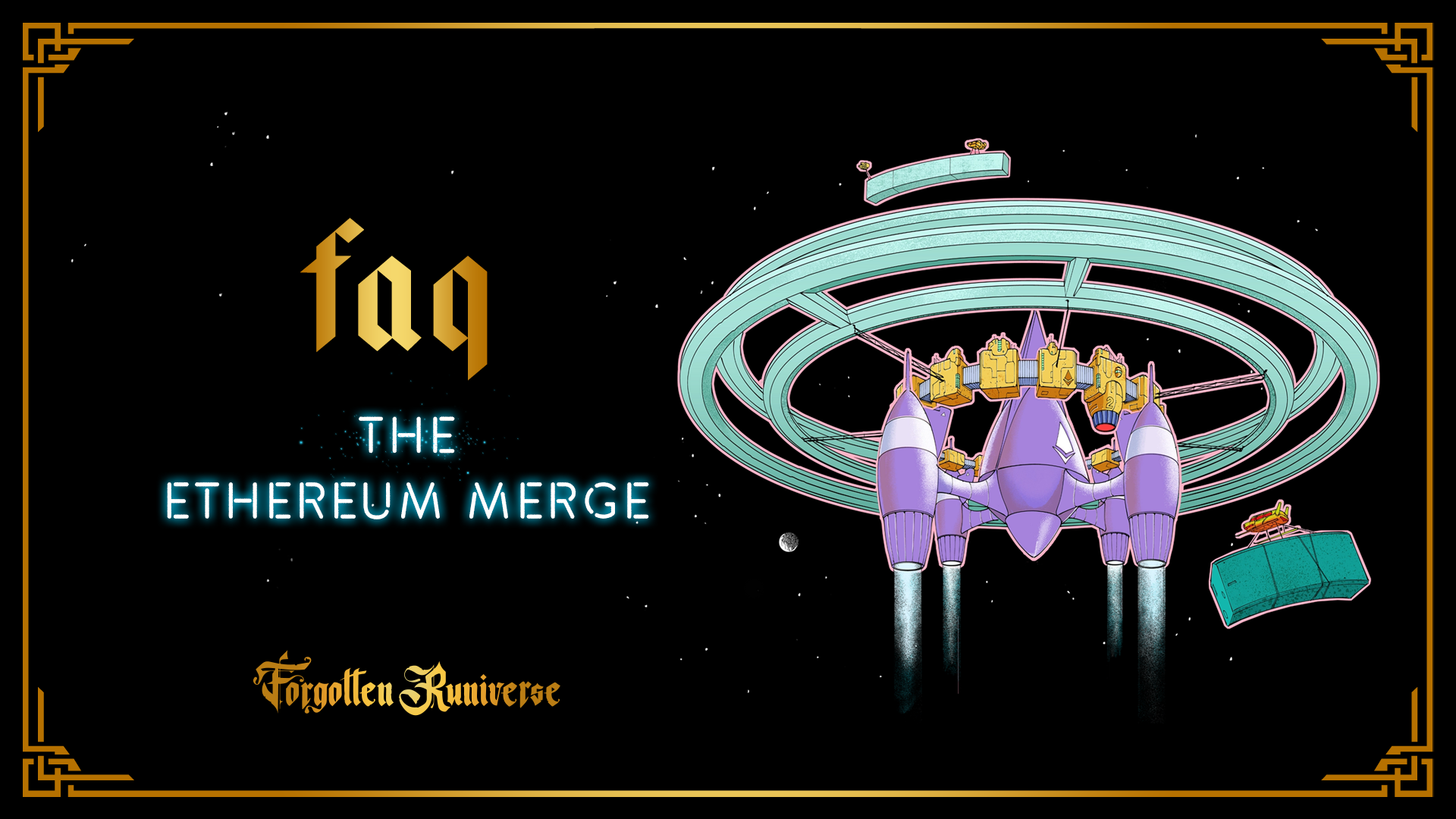Ethereum Merge FAQ

On September 13, the Ethereum Merge will move Ethereum from Proof or Work to Proof of Stake! (We’re celebrating with a giveaway here.) The Merge sets the stage for future scalability and will lower the energy usage of the entire chain by ~99.95%. Despite how drastic of an update this event will be, there is zero downtime scheduled!
(Note – the merge is actually applied based on block timing, meaning the exact time of the update may change.)
It’s an exciting time for the crypto, but also a little confusing, so we’re here to help you understand what’s going on!
Q: I heard that Ethereum will split into two new chains after the merge! Will this cause any complications? Will my NFTs duplicate?
Yes it will split, but no you shouldn’t see any complications. Because of the decentralized nature of Ethereum, not all miners maintaining the Ethereum network will update to the new Proof of Stake consensus. This means that the Proof of Work version of Ethereum will continue to exist and be maintained even though the majority of the network has converted to Proof of Stake. These two networks will diverge into their own unique chains! Transactions performed on Ethereum Proof of Work will not apply to the Proof of Stake chain and vice versa.
Because they both started from the same point, this means all wallet balances and transaction history from before the split will be shared between them. An exact copy of your wallet pre-merge will also exist on the Ethereum Proof of Stake chain. Fear not, the vast majority of users and exchanges will not be interacting with the now old Proof of Work chain. Issuers of widely used tokens such as USDC will not honor any copied tokens, meaning most everything on the Proof of Work chain will have no value.
You will not need to take any action to choose between one chain or the other. While there will technically be mirrored versions of your assets on another (the old) chain, they will not interfere with your main holdings.
Q: Will transactions become cheaper after the Merge?
Generally, no. The Merge will create a foundation for future updates to reduce the cost of transactions, but the Merge alone will do very little to change transaction costs. Originally, many large updates were scheduled to roll out around the same time in what was once called “Eth 2.0”, which had gas efficiency updates baked in to reduce costs. But because of Ethereum’s strong open sourced dev community creating scaling solutions such as L2 rollups helping out with transaction cost and speed, priority was placed on sectioning this huge update into smaller releases that could be rolled out earlier.
Q: Will the Merge make ETH into a deflationary asset?
Not necessarily. The Merge will primarily mark a huge change in ETH emissions. You can learn more by looking the edynamic fee structure and articles about how ETH will automatically adjust to be inflationary or deflationary at times. It’s important to recognize that some influencers try leaning too hard into the hype to pump bags, and while current models definitely show that at average network usage there will be more ETH burned from transactions than issued to validators, this isn’t always going to be the case at all times.
Q: Do I need to do anything to make sure I’m on the right chain post merge?
No, the average user doesn’t have to do anything on their part during this upgrade. You won’t have to update Metamask settings, or create a new wallet or anything of the sort. Be careful of scammers that may try to use this period of uncertainty and confusion to trick you. Again you will not need to do anything. Do not follow links from strangers, and be wary of potential fake Metamask popups requesting you re-enter your seed phrase to get back onto the network!
Q: Why does the date of the merge keep changing? Will it be delayed?
The time for Ethereum’s update dynamically shifts because it isn’t set to roll out at a dedicated real world time, rather it’s set to happen based on blockchain timing. Each time a new block of data is mined on the Ethereum network, the total difficulty level for minting the next block increases. Rather than using a date and time for the merge, it will happen when a specific difficulty level has been reached. For now we only have approximations based off blockchain usage on when that will be, but you can see updated predictions on this site: https://bordel.wtf/
Q: Will I lose assets if I transact on the day of the Merge?
No, it will be safe to transact on the day of the Merge. Some exchanges may temporarily pause withdrawals or deposits into their wallets during this time, but the goal of the Merge is to be an entirely seamless transition.
Q: Does Proof of Stake make Ethereum less secure from a network takeover?
Proof of Stake strengthens the Ethereum network’s security by creating harsh penalties for bad actors who attempt to attack the chain. The ETH that is staked in order to run a validation node acts as collateral that is locked up for at least 6 months. Penalties against this ETH will be placed if they attempt to manipulate the network in any way. If one entity or group owns more than 51% of the network nodes, the Ethereum community can initiate a soft fork of the network that completely penalizes all of the attacker’s staked ETH to restore decentralization to the network. To learn more about this, you can read Vitalik’s tweet thread regarding 51% attacks and the protections Proof of Stake have against them here: https://twitter.com/VitalikButerin/status/955482751750361088

Q: What’s this you said about a giveaway?
We’re super excited about the merge and what it means for Ethereum as a sustainable platform moving forward so we’re celebrating with a giveaway! You can sign up on this Premint page for a chance to win one of ten prizes of .1 ETH along with a Forgotten Runes swag pack!





